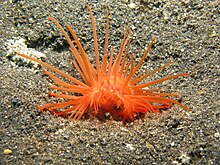| Limaria fragilis | |
|---|---|

| |
| Scientific classification | |
| Domain: | Eukaryota |
| Kingdom: | Animalia |
| Phylum: | Mollusca |
| Class: | Bivalvia |
| Order: | Limida |
| Family: | Limidae |
| Genus: | Limaria |
| Species: | L. fragilis |
| Binomial name | |
| Limaria fragilis (Gmelin, 1791) | |
| Synonyms | |
| |
Limaria fragilis, the fragile file clam, is a species of bivalve mollusc in the family Limidae. It is found in shallow waters in the Indian and Pacific Oceans and has the ability to swim.
Description
The fragile file clam has a pair of hinged, thin, asymmetric white valves and a red mantle with a fringe of long tapering pink and grey banded tentacles at its edge. Also around the margin of the mantle are a row of tiny eyespots that can detect light and shade, and may alert the animal to the approach of a predator.
Distribution and habitat
The fragile file clam is widely distributed in the Indo-Pacific region. Its range includes the Philippines, the Marshall Islands, the Cook Islands, Western Australia, the Chagos Archipelago, Madagascar and the Red Sea. It often conceals itself in crevices or under stones with just its tentacles protruding.
Biology
The fragile file clam is a protandrous hermaphrodite. Juveniles start life as males and change sex to females as they grow. Fragile file clams have the ability to emit flashes of bioluminescent light, though why they do this is unclear.
The fragile file clam can swim slowly and continuously for about 5 minutes at a time. It does this by opening and closing its valves and expelling water in a stream from either side of the hinge, a form of jet propulsion. In an aquarium, the animal flits around knocking into other objects. It uses its mantle tentacles in an oar-like fashion when swimming. Sometimes it sheds the longest tentacles and can still swim effectively without them, increasing the frequency of valve clapping to maintain speed. The detached tentacles secrete a noxious substance and continue to writhe after they are severed which may distract aggressors.
It was originally thought that the energy for swimming was supplied aerobically through respiration with little input from anaerobic glycolysis and arginine phosphate. Further study showed that this was not the case. There was a high level of arginine kinase and certain other enzymes in the adductor muscles which was indicative of the conversion of arginine phosphate for energy production. Up to 23% of the ATP used for energy transfer was supplied in this way while the animal was swimming.
References
- ^ Huber, Markus (2010). "Limaria fragilis (Gmelin, 1791)". WoRMS. World Register of Marine Species. Retrieved 2012-04-20.
- ^ Limaria fragilis Saltcorner. Retrieved 2012-04-20.
- ^ Baldwin, J.; Morris, G. M. (1983). "Re-examination of the contributions of aerobic and anaerobic energy production during swimming in the Bivalve mollusc Limaria fragilis (Family Limidae)". Australian Journal of Marine and Freshwater Research. 34 (6): 909–914. doi:10.1071/MF9830909.
- Fleming, P. A.; Bateman, P. W. (2007). "Just drop it and run: the effect of limb autotomy on running distance and locomotion energetics of field crickets (Gryllus bimaculatus)". Journal of Experimental Biology. 210 (8): 1446–1454. doi:10.1242/jeb.02757. PMID 17401127.
- Fleming, P. A.; Muller, D.; Bateman, P. W. (2007). "Leave it all behind: a taxonomic perspective of autotomy in invertebrates". Biological Reviews. 82 (3): 481–510. doi:10.1111/j.1469-185X.2007.00020.x. PMID 17624964.
External links
- Photos of Limaria fragilis on Sealife Collection
| Taxon identifiers | |
|---|---|
| Limaria fragilis | |